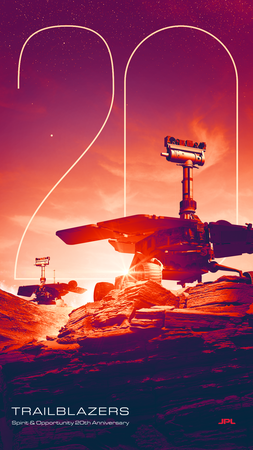
20 Years After Landing: How NASA’s Twin Rovers Changed Mars Science

On the 20th anniversary of the landing of Spirit and Opportunity, celebrate NASA’s Mars Exploration Rover project with this two-sided poster that lists some of the pioneering explorers’ accomplishments on the Red Planet. Download the poster for free here.
Credit: NASA/JPL-Caltech
In January 2004, twin NASA rovers named Spirit and Opportunity touched down on opposite sides of Mars, kicking off a new era of interplanetary robotic exploration. They arrived in dramatic fashion three weeks apart, each nestled in a cluster of airbags that bounced along the surface around 30 times before coming to a stop and deflating. The golf cart-size rovers’ mission: to look for evidence that water once flowed on the Red Planet’s surface.
Their findings would rewrite science textbooks, including Opportunity’s discovery soon after landing of the famous “blueberries” – spherical pebbles of the mineral hematite that had formed in acidic water. Several years into the mission, Spirit, undaunted but now dragging a damaged wheel, uncovered signs of ancient hot springs that could have been ideal habitats for microbial life billions of years ago (if any ever existed on the Red Planet).
Scientists suspected Mars had long ago been radically different than the freezing desert it is today: Orbital images had shown what looked like networks of water-carved channels. But before Spirit and Opportunity, there was no proof that liquid water had formed those features.
“Our twin rovers were the first to prove a wet, early Mars once existed,” said former project scientist Matt Golombek of NASA’s Jet Propulsion Laboratory in Southern California, which managed the Mars Exploration Rover mission. “They paved the way for learning even more about the Red Planet’s past with larger rovers like Curiosity and Perseverance.”
An Enduring Legacy
Thanks in part to the science collected by Spirit and Opportunity, NASA approved development of the SUV-size Curiosity rover to investigate whether the chemical ingredients that support life were present billions of years ago on what was once a watery world. (The rover found soon after its 2012 landing that they were.)
Perseverance, which arrived at the Red Planet in 2021, is building on Curiosity’s success by collecting rock cores that could be brought to Earth to check for signs of ancient microbial life through the Mars Sample Return campaign, a joint effort by NASA and ESA (European Space Agency).
While working on Spirit and Opportunity, engineers developed practices for exploring the surface that continue today, including the use of specialized software and 3D goggles to better navigate the Martian environment. And after honing years of expertise during the twin rovers’ travels over Mars’ rocky, sandy surface, engineers are able to plan safer, longer drives, and to quickly put together the far more complex daily plans required to operate Curiosity and Perseverance.
Science team members have also become more adept in their role as virtual field geologists, drawing on years of knowledge to select the best ways to investigate Martian terrain using the robotic “eyes” and tools carried by their roving partners.
Martian Marathon
Designed to last just 90 days, Spirit landed on Jan. 3; Opportunity, on Jan. 24. The solar-powered Mars Exploration Rovers soldiered on for years – in the case of Opportunity, nearly 15 years, before succumbing to a planet-enveloping dust storm in 2018. That durability surpassed the wildest dreams of scientists and engineers, who had only expected localized exploration over a distance of no more than one-third of a mile (600 meters).
Instead, through their long-lived robotic surrogates, the team got the chance to roam a wide variety of Martian terrains. Opportunity, the first rover to go a marathon-length distance on another planet, would ultimately cover nearly 30 miles (45 kilometers) in total – the farthest distance driven on another planet.
“This was a paradigm shift no one was expecting,” said former project manager John Callas of JPL. “The distance and time scale we covered were a leap in scope that is truly historic.”
The chance to see so much was critical for revealing that not only was Mars once a wetter world, but also that it supported many different kinds of watery environments – fresh water, hot springs, acidic and salty pools – at distinct points in its history.
This artist’s concept depicts one of NASA’s Mars Exploration Rovers on the Red Planet. The twin rovers, Spirit and Opportunity, landed in 2004 and lasted years beyond their expected 90-day mission. Credit: NASA/JPL-Caltech
Continuing Inspiration
The roving twins would also inspire a new generation of scientists. One of those was Abigail Fraeman, who was a high school student invited to JPL on the night of Opportunity’s landing. She got to watch the excitement as the first signal returned, confirming Opportunity had safely landed.
She would go on to pursue a career as a Mars geologist, returning to JPL years later to help lead Opportunity’s science team. Now deputy project scientist for Curiosity, Fraeman calls many of the people she met on Opportunity’s landing night her close colleagues.
“The people who kept our twin rovers running for all those years are an extraordinary group, and it’s remarkable how many have made exploring Mars their career,” Fraeman said. “I feel so lucky I get to work with them every day while we continue to venture into places no human has ever seen in our attempt to answer some of the biggest questions.”
More About the Mission
JPL, a division of Caltech in Pasadena, California, managed the Mars Exploration Rover Project for NASA’s Science Mission Directorate in Washington.
For more information about Spirit and Opportunity, visit:

